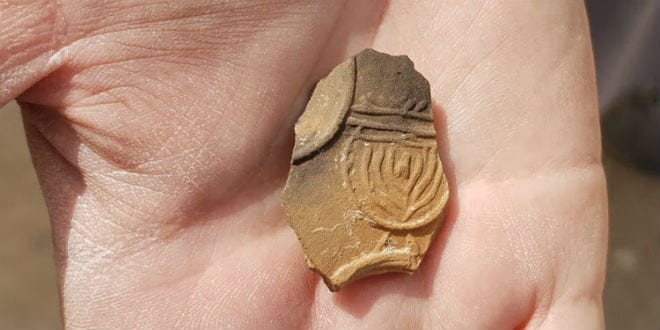Israel Antiquities Authority archaeologists have uncovered remains of Jewish settlement from 2,000 years ago in the southern Israeli city of Beersheba.
The excavations, carried out in conjunction with Ben-Gurion University of the Negev, have revealed evidence of day-to-day Jewish life in the town, including part of an oil lamp decorated with a nine-branched menorah – one of the earliest yet discovered by researchers – as well as limestone vessels used by Jews for reasons of ritual purity, a watchtower and more.
This particular site – dated from the 1st century CE until the Bar Kochba Revolt in 135 CE – also appears to show evidence of passageways used by Jewish rebels.
According to the excavators, Dr. Peter Fabian of the Ben-Gurion University in the Negev and Dr. Daniel Varga of the Israel Antiquities Authority, “Remains of the settlement cover an area of c. 2 dunams (approximately half an acre) and include several structures and installations, such as the foundations of a large watchtower, baking facilities, ancient trash pits and an underground system that was probably used as a Jewish ritual bath (mikveh). Signs of a conflagration discovered in some of the structures evince a crisis that the settlement experienced, probably that of the First Jewish Revolt in c. 70 CE.”
The site is located along the southern border of the ancient kingdom of Judah next to a road that led from Tel Beer Sheva (which has evidence of settlement from the 8th century BCE) to the southern coastal plain. Researchers estimate that the watchtower was approximately 10 x 10m – the foundations of which were uncovered in the excavation – showing the site’s strategic value along the road.
The most exciting find was the sherd on which the image of the nine-branched menorah (candelabra) was revealed.
“This is probably one of the earliest artistic depictions of a nine-branched menorah yet discovered,” said Fabian and Varga. “It is interesting to note that of the few lamps found depicting a menorah, these are never seven-branched. This was in accordance with a ruling in the Babylonian Talmud [written during the Babylonian exile in the 6th century BCE] stating that only the menorah in the Temple could have seven branches and thus lamps used in domestic contexts commonly had eight to eleven branches.”
Dozens of bronze coins discovered at the site belong to the period of Roman provincial rule. Some were minted in Ashkelon and others were minted in cities from throughout the Roman Empire.
Source: Israel in the News

